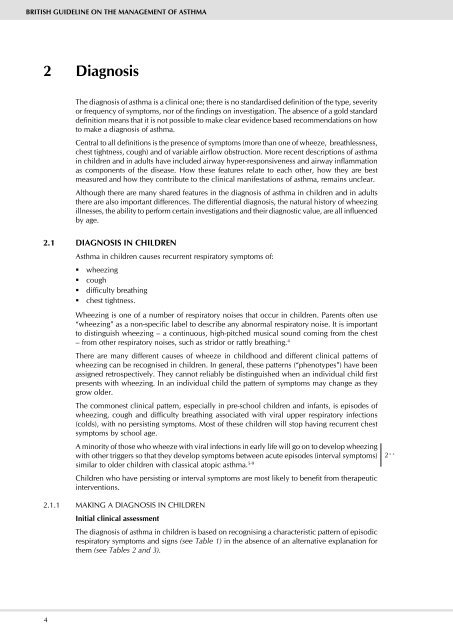sign101
sign101
sign101
Create successful ePaper yourself
Turn your PDF publications into a flip-book with our unique Google optimized e-Paper software.
British Guideline on the MAnAGeMent of AsthMA<br />
2 diagnosis<br />
4<br />
The diagnosis of asthma is a clinical one; there is no standardised definition of the type, severity<br />
or frequency of symptoms, nor of the findings on investigation. The absence of a gold standard<br />
definition means that it is not possible to make clear evidence based recommendations on how<br />
to make a diagnosis of asthma.<br />
Central to all definitions is the presence of symptoms (more than one of wheeze, breathlessness,<br />
chest tightness, cough) and of variable airflow obstruction. More recent descriptions of asthma<br />
in children and in adults have included airway hyper-responsiveness and airway inflammation<br />
as components of the disease. How these features relate to each other, how they are best<br />
measured and how they contribute to the clinical manifestations of asthma, remains unclear.<br />
Although there are many shared features in the diagnosis of asthma in children and in adults<br />
there are also important differences. The differential diagnosis, the natural history of wheezing<br />
illnesses, the ability to perform certain investigations and their diagnostic value, are all influenced<br />
by age.<br />
2.1 diAGnosis in Children<br />
Asthma in children causes recurrent respiratory symptoms of:<br />
wheezing<br />
cough<br />
difficulty breathing<br />
chest tightness.<br />
Wheezing is one of a number of respiratory noises that occur in children. Parents often use<br />
“wheezing” as a non-specific label to describe any abnormal respiratory noise. It is important<br />
to distinguish wheezing – a continuous, high-pitched musical sound coming from the chest<br />
– from other respiratory noises, such as stridor or rattly breathing. 4<br />
There are many different causes of wheeze in childhood and different clinical patterns of<br />
wheezing can be recognised in children. In general, these patterns (“phenotypes”) have been<br />
assigned retrospectively. They cannot reliably be distinguished when an individual child first<br />
presents with wheezing. In an individual child the pattern of symptoms may change as they<br />
grow older.<br />
The commonest clinical pattern, especially in pre-school children and infants, is episodes of<br />
wheezing, cough and difficulty breathing associated with viral upper respiratory infections<br />
(colds), with no persisting symptoms. Most of these children will stop having recurrent chest<br />
symptoms by school age.<br />
A minority of those who wheeze with viral infections in early life will go on to develop wheezing<br />
with other triggers so that they develop symptoms between acute episodes (interval symptoms)<br />
similar to older children with classical atopic asthma. 5-9<br />
Children who have persisting or interval symptoms are most likely to benefit from therapeutic<br />
interventions.<br />
2.1.1 MAKING A DIAGNOSIS IN CHILDREN<br />
initial clinical assessment<br />
The diagnosis of asthma in children is based on recognising a characteristic pattern of episodic<br />
respiratory symptoms and signs (see Table 1) in the absence of an alternative explanation for<br />
them (see Tables 2 and 3).<br />
2 ++


